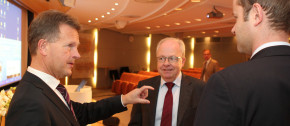
How CFOs and CEOs of Different Stripes Can Communicate Better
By vantagecost on March 12, 201400Read moreNow that you know what type of CFO you are, and what type of CEO you’re working with, you should have a better idea of how to communicate with them in a manner that speaks to their core agenda, attributes and values.
Here, we provide CFOs a handy cheat sheet for crafting a communication strategy that’s tailored to the kind of CEO to which they report. Following, we outline the ideal pairings—and least ideal pairings—of CFO and CEO working relationships. Then, to help you improve that working relationship, we offer a general strategy tip for formulating your talking points with the four types of CEOs, regardless of what type of CFO you happen to be.
Finally, we assign each CEO a likely StrengthFinder strength theme, which is based on a more than 40-year study of human strengths, and offer tips from the book StrengthsFinder 2.0 to work the best with this type of CEO.

The 4 Types of CEOs
By vantagecost on March 5, 2014Read moreEditor’s Note: This is the second in a three-part series on the different types of CFOs, CEOs, and how they can best communicate with each other. In this post, we outline the four different types of CEOs. In post one, we outlined the four different types of CFOs. The third post will offer tips toward better, clearer and more productive communication between different stripes of CFOs and CEOs.
Different strokes for different folks, the old saying goes. Perhaps in no arena is that more true when it comes to the leadership styles of CEOs. And while there are many different combinations of leadership styles and traits that figure into different C-suite leaders, we’ve distilled them into four essential archetypes of CEOs.

The 4 Types of CFOs: Which Are You?
By vantagecost on February 27, 2014Read moreEvery CFO, like every leader, has their own executive style. Some are dyed-in-the-wool cost cutters, with a preternatural skill of haggling vendors for the best deals. Others, meanwhile, excel at growth-minded value creation, with their 5-year projections and treasury analyses carefully plotted on the nearest whiteboard in their office or spreadsheet on their laptop.
Each style brings with it a different set of advantages and disadvantages, strengths and weaknesses. But one of the most important aspects of assessing which type of CFO you are is understanding how to mesh that style with your CEO (Don’t forget: your effectiveness is directly linked to the quality of that relationship.)
In an excellent January 2013 article, McKinsey consultants Ankur Agrawal, John Goldie, and Bill Huyett outlined four types of CFOs. We build on their work, and offer tips on how CFOs can best work with their CEO—while offering a few strengths and weaknesses of each type.

How Big Companies Use Strategic Sourcing (And How You Can, Too)
By vantagecost on February 19, 2014Read moreCFOs at the best companies across the globe have a secret weapon that allows them to reduce risk, trim expenditures, deal with fewer invoices, manage fewer suppliers and fuel their growth.
Their secret: strategic sourcing, an iterative, institutional approach to supply-chain management.
Strategic sourcing has several key objectives, according to GE Capital, including:
Establishing a framework to improve the quality, service and technology of goods and services your organization consumes; Developing the tools and capabilities that enhance visibility into those goods and services consumed; and Developing standard agreements and templates.
Over time, the benefits of these practices compound, leaving an organization in a competitive posture to grow, expand and innovate. “As strategic sourcing programs mature, the benefits extend beyond cost savings to breakthrough innovations and productivity improvements that drive revenue growth,” according to GE.

Start With Why
By vantagecost on February 5, 2014Read more“It doesn’t matter what you do, it matters why you do it.”
-Simon Sinek
A cocktail party or networking event wouldn’t be complete without the question, “So, what do you do?” I don’t know if it conveys what we’re interested in hearing as much as it conveys what we’re most comfortable talking about. Have you ever been asked why you do what you do? What would you say?
Most CFO’s have an analytical view of the world that bends toward the practical, so a discussion with a lot of ‘why’s’ doesn’t exactly fall within the realm of the comfort zone. But, Simon Sinek does a great job in this TED Talk challenging you to really connect with your own reasons why you do what you do, and illustrating how great brands are built on the foundation of starting with why. If you don’t have time to watch the video, I picked out two of the most powerful quotes:
Achieving Your Childhood Dreams
By vantagecost on February 4, 2014Read moreThe “last lecture” is common with a lot of professors on college campuses. Professors are asked to consider what matters most to them. If you’ve ever sat in the audience for one of these lectures you can’t help but wonder what wisdom you’d want to impart to the world if it was your last chance?
Randy Pausch, a computer science professor at Carnegie Mellon, gave such a lecture. Only he didn’t have to imagine it was his last act because he had recently been diagnosed with terminal cancer.
“That is what it is. We can’t change it. We just have to decide how we’ll respond. We cannot change the cards we are dealt, just how we play the hand.”
The Last Lecture is a summary of all Pausch had learned and all he wanted to pass along to his children. The lecture, entitled “Really Achieving Your Childhood Dreams,” wasn’t about dying rather just the opposite. It was about dreams, moments and overcoming obstacles because “time is all you have…and you may find one day that you have less than you think.”
What the Most Successful People Do Before Breakfast
By vantagecost on January 31, 2014Read moreMornings are an underutilized tool to aid productivity.
Let me explain.
We’re often at our peak in the mornings. This is why Mark McGuinness suggests the single most important change you can make to your workday is to move your creative time to mornings. We’re more mentally alert and our mental batteries are charged.
Where do we spend all of this energy? Email. Meetings. We fragment our time. This, however, isn’t the path to success. There is another way.

How to Expand Your C-Suite’s Firepower Without Hiring
By vantagecost on January 29, 2014Read moreAs a CFO, you’re being tasked to do more with less—now more than ever.
In addition to core duties, your CEO has his or her own ideas of what your priorities should be: Growth efforts. Cost-cutting programs. Keeping the board in the loop. Revamping your firm’s procurement practices.
As your responsibilities pile up, you need to triage core and non-core tasks, keeping your focus on those tasks that as a CFO, no other key personnel can handle—and offloading all non-core duties.
To do that, you could hire a vice president of finance, but with hiring this year expected to increase only by a modest 1.3 percent, it’s unlikely your CEO is willing to authorize additional hires in the C-suite.
We have you covered. Here is a proven process to offload the projects your CEO wants to see accomplished, while maintaining your firm grip on key initiatives that only you can handle.

How Middle Market Companies Waste at Least $500,000 Annually (And 3 Ways to Stop the Bleeding)
By Vantage Cost on January 22, 2014Read moreInside most middle market companies, they’re lurking.
They bedevil CFOs. They creep upwards each year. And worst of all, they shrink the firm’s bottom-line, without adding value to the customer’s experience.
They’re indirect expenses—purchased goods and services that don’t end up in the products or services delivered to customers—and they’re monopolizing up to 20 percent of your organization’s revenue.
For an average middle market company with revenues between $50 million and $2 billion, you’re throwing away 1 percent to 2 percent of your revenue in lost supply chain savings every year, according to Accenture’s CFO Insights survey.
Because they are fragmented throughout the organization, indirect expenses are often your firm’s primary source of inefficient spending.
So how do you address this insidious threat to your bottom-line? At Vantage, we help companies see savings where others don’t with our Three-S process.

Why You Should Hire a Third Party to Lead Your Cost-Reduction Efforts
By Vantage Cost on January 15, 2014Read moreBy nature, CFOs and their direct reports are confident in their abilities to wrangle budgets, contain and cut costs.
And judging from my experience, they should be: they’re some of the most analytical, and knowledgeable people with whom I’ve had the privilege to work.
Still, there are certain projects that demand more resources than what many mid-market firm CFOs and their staffs can muster. Chief among these kinds of projects: corporate-wide cost reduction campaigns.
Here are three reasons why you should hire a third party to lead your next cost-reduction campaign.

